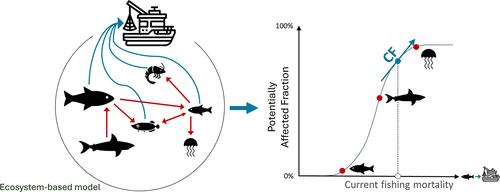渔业生命周期影响评价中的生态系统尺度生物多样性
IF 11.3
1区 环境科学与生态学
Q1 ENGINEERING, ENVIRONMENTAL
引用次数: 0
摘要
渔业的影响最近被纳入生命周期评估,在区域和全球范围内考虑对单个被捕捞物种的影响。现在,通过整合生态系统动态,将与捕鱼相关的额外间接影响纳入其中,这一新兴途径扩展到生态系统规模。该方法结合了动态生态系统建模和物种敏感性分布曲线的新耦合,使用usutox效应因子模型来评估社区尺度的生态毒性影响,以量化渔业对海洋生物多样性的影响。创新元素包括通过捕食者-猎物相互作用,通过被捕捞群落纳入间接影响,以及双向阈值间隔,以捕获潜在的种群枯竭和开发导致的扩张动态。在亚得里亚海提出了一个概念验证,为26个已开发的官能团提供了新的中点表征因子,并在潜在影响分数(PAF)单位中报告了影响。影响值分布在6个数量级(1.58× 10-7 PAF中小型射线- 2.16 × 10-1 PAF小型远洋鱼类),验证了该方法的可操作性。讨论了新方法所引入的方法选择和假设。该表征方法中采用的建模工具的原始组合有助于逐步增强渔业影响途径,以及如何在生命周期影响评估中考虑生物多样性损失。本文章由计算机程序翻译,如有差异,请以英文原文为准。

Ecosystem-Scale Biodiversity in Fisheries Life Cycle Impact Assessment
The impact of fisheries was recently operationalised in Life Cycle Assessment, accounting for effects on individual exploited species at both regional and global scales. Now, this emergent pathway is expanded to the ecosystem scale by incorporating additional indirect impacts associated with fishing through the integration of ecosystem dynamics. The methodology combines a novel coupling of dynamic ecosystem modeling and species sensitivity distribution curves to quantify fisheries effects on marine biodiversity, using an adaptation of the USEtox effect factor modeling that assesses community-scale ecotoxicity impacts. Innovative elements include the incorporation of indirect effects through a fished community via predator–prey interactions, and a bidirectional threshold interval that captures both potential population depletion and expansion dynamics resulting from exploitation. A proof of concept is presented in the Adriatic Sea, deriving novel midpoint characterization factors for 26 exploited functional groups, with impacts reported in potentially affected fraction (PAF) units. Impact values are spread over 6 orders of magnitude (1.58× 10–7 PAF small/medium rays −2.16 × 10–1 PAF small pelagic fish), validating the operability of the approach. Methodological choices and assumptions introduced by the novel approach are discussed. The original combination of modeling tools employed in this characterization approach contributes to the progressive enhancement of the fisheries impact pathway and how biodiversity loss is considered in life cycle impact assessment.
求助全文
通过发布文献求助,成功后即可免费获取论文全文。
去求助
来源期刊

环境科学与技术
环境科学-工程:环境
CiteScore
17.50
自引率
9.60%
发文量
12359
审稿时长
2.8 months
期刊介绍:
Environmental Science & Technology (ES&T) is a co-sponsored academic and technical magazine by the Hubei Provincial Environmental Protection Bureau and the Hubei Provincial Academy of Environmental Sciences.
Environmental Science & Technology (ES&T) holds the status of Chinese core journals, scientific papers source journals of China, Chinese Science Citation Database source journals, and Chinese Academic Journal Comprehensive Evaluation Database source journals. This publication focuses on the academic field of environmental protection, featuring articles related to environmental protection and technical advancements.
 求助内容:
求助内容: 应助结果提醒方式:
应助结果提醒方式:


